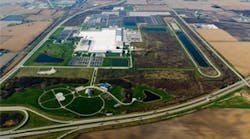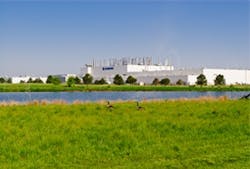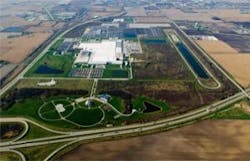A subsidiary of Fuji Heavy Industries, SIA is the home of North American Subaru production. The Subaru Legacy, Outback, and Tribeca are built here, along with the Toyota Camry, which was added in 2007. SIA employs more than 3,600 associates, and the plant's ability to attract Toyota as an assembly customer is a testament to its skill and quality ethic. But the remarkable facts about the plant don’t stop there.
In May 2004, SIA became the first auto assembly plant in America to achieve zero landfill status. SIA’s entire 832-acre site with six ponds has been designated a backyard wildlife habitat by the National Wildlife Federation.
Effectiveness and efficiency
In May 2012, SIA announced a $75 million expansion to increase production of current model lines. Then in May 2013 it announced that Subaru would be making a $400 million investment at SIA and adding 900 jobs to produce the Impreza model beginning in 2016. The new expansion will push the plant capacity to 400,000 vehicles/year.
“The success of the Subaru brand can be credited, in part, to the dedication of SIA’s highly skilled associates,” says SIA Executive Vice President Tom Easterday. “Our associates are very excited about the opportunity to build the Subaru Impreza and will remain committed to the same high level of quality, safety and teamwork that goes into every Subaru built here.”
Corporate citizenship
Easterday references the three Rs of environmental stewardship — reduce, reuse, recycle. "Focus on these fundamentals," he says. "You have to focus in that order. Reduce first. What you can't reduce, you reuse. Then you recycle. Here’s an example of reduction— ultrasonic weld testing. Steel scrap in the automotive industry is by far the biggest waste. The old method of testing weld quality was to literally tear apart the vehicle to determine the strength of each weld. Today we use nondestructive ultrasonic weld testing, reducing the amount of scrap we generate. There's a cost savings, and it improves quality.”
SIA associates suggest energy kaizens that pay green dividends, says Easterday. "These have included the elimination of most light ballasts, adding more switches and reducing excess lighting," he explains. "Energy is the third largest expense, after employees and real estate, representing 19% of our cost.”
As to reuse, Easterday cites several examples. "Approximately 1.5 million caps were sent back to suppliers for reuse in 2012," he says. "We have styrofoam covering transmissions as they come over from Japan. Six hundred seventy tons of styrofoam were returned to Japan in 2012. That's a savings of $1.3 million. One associate’s suggestion saved us $1.3 million last year. After being sent back and forth to Japan four times, the foam becomes a cost saving. We have some that have been sent back as many as 21 times. All bumper scrap is reused for a $140,000 annual savings.”
In 2012, SIA recycled 1,000 tons of scrap metal, 1,632 tons of cardboard and paper, and 83 tons of wood, says Easterday. "A lot of times, companies hire someone to come in from the outside and recycle, but you need to be sure your associates are at the heart of it," he explains. "Those kaizen events are important. We have three associates who have won Subaru Legacy vehicles for their kaizens. Look for those creative ideas and be proactive.”
What do you do once you get to zero landfill? “You go after additional energy and CO2 reduction," suggests Easterday. "Electricity rates are continuing to go up, so you have to do something," he explains. "Regarding water reduction or reuse, a lot of municipalities are raising water rates. We have a lot of water that flows through our paint process. and we're looking at ways to generate electricity with that. We have on-site composting. All of our potato-based cafeteria waste is put into the composter. We have associates who can say their last week's leftovers from lunch are now going to growing vegetables.”
SIA's native prairie grass project is also now underway. "We have grasslands on site," says Easterday. "We got rid of invasive species, and now we're letting that native prairie grass grow. It's become very cost-efficient because we don't have to cut the grass there. We're the only automotive plant in American to be designated a wildlife refuge. There’s a blue heron refuge in the interior of our 2-mile test track.”
Clearly the SIA operation is not resting on its laurels. If anything, it’s recycling them. The exciting result is good business and environmental awareness supporting each other. The 21st century has arrived in Lafayette, Indiana.



